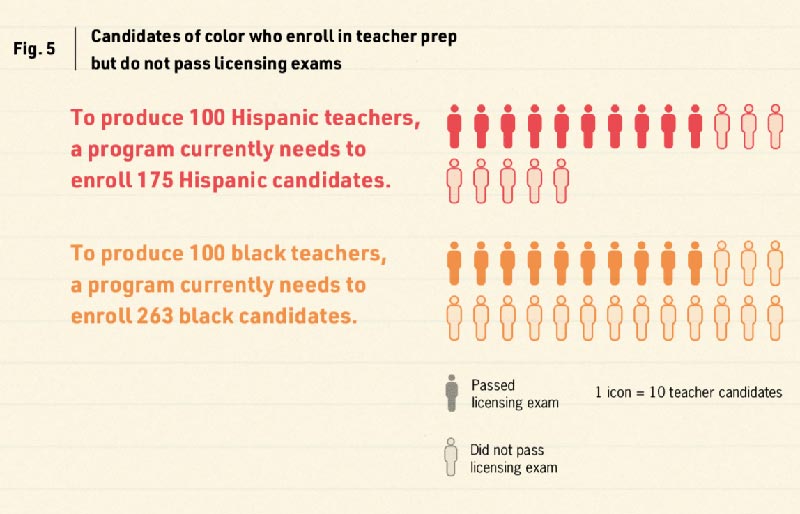A New Study Shows How Simple Policy Measures Can Promote More Diverse Teacher Representation

It seems obvious that a diversifying student population merits more diverse teachers. However, a new study by the National Council on Teacher Quality says many teachers of color aren’t obtaining these jobs because of high failure rates on licensing tests, rates higher than those of bar exams and medical boards, raising serious concerns about the content of the tests and what preparation would-be teachers are receiving to plan for these exams.
The report, titled A Fair Chance: Simple Steps to Strengthen and Diversify the Teacher Workforce, says pass rates are 38% for Black candidates, 57% for Latino candidates, and 75% for White candidates.
“These results are at the forefront of policy discussions because of the renewed imperative to increase diversity in the teaching profession,” the report states, adding that a growing number of people are calling for the end of the licensing tests in an effort to build this diversity. “This call is unprecedented, as the need for teachers to demonstrate by some valid means that they know their subject matter has rarely been a subject of debate.”
To delve into the problem, the report’s authors investigated whether the tests are too difficult or potentially biased; if the knowledge required actually matches elementary school teaching standards; whether teachers who pass the tests are actually more effective; and whether this stringent teacher licensing could be exacerbating the teacher shortage.
The issue began in the 1990s when states began relying not just on a teacher’s performance on prior coursework but their scores for these newly created standardized teaching tests. But over the years, even many teachers who successfully passed the tests have said they are left to teach “on the fly,” complaining that they themselves don’t feel prepared to teach some of the required coursework.

The report included a study of 817 undergraduate elementary teacher prep programs across the nation to see if there could be a gap in teacher training. The findings showed that:
- Only half of the required coursework on composition and writing includes information on or access to children’s literature.
- Only one in four programs covers all required elementary math material.
- Only one in three programs requires geography.
- Two-thirds of teaching programs do not require a single science course.
“Essentially this means we’re failing all of our teachers from the time they enter teacher preparation programs, with really terrible outcomes for teachers of color,” says UnidosUS Vice President of Education and Workforce Development Peggy McLeod, who reviewed and provided feedback on the report.
The second half of the report shows just how impactful these gaps—and closing them—can be. For example, it cites data from a National Bureau of Economic Research report showing that black male students with just one black male teacher in grades three to five were 50% less likely to drop out of high school.
At the same time, it warned that some teachers aspiring to work in underserved schools like the ones they themselves grew up in can inadvertently set their students up for failure. In fact, the report notes that teachers with content knowledge gaps are more likely to be found working in lower-achieving schools with larger numbers of children who are students of color and/or low-income.
“This inequitable distribution of teachers can be self-perpetuating,” the report said, noting that less knowledgeable teachers can end up contributing to “an endless cycle, producing more students who go on to become teachers with gaps in their knowledge as well.”

But more data is needed to find the best ways of closing these kinds of teaching and representational gaps, and that’s something National Council on Teacher Quality hopes to provide in forthcoming reports.
“The findings of this report point to the need for better teacher preparation programs and tighter accountability for these programs which are producing such poor results,” says McLeod.
In the meantime, it offered a number of solutions that could be easily implemented to move the U.S. education system in a new, more diverse direction.
For example, it suggests that colleges and universities could strengthen and diversify the teacher workforce by:
- Providing parameters around which courses outside of the actual major in education could are the most relevant.
- Identifying weaknesses in content knowledge during the admissions process to determine how to help fill in the gaps.
- Match undergraduate teaching coursework to key curriculum requirements for elementary school teachers.
“Of all the different strategies to try and attract more individuals of color to the teaching profession, here we surface thousands of candidates a year who want to teach, who would teach, but whose institutions are not providing what they need to be successful. Few challenges faced by the teaching profession can be solved as easily as this one—just guide them to the right coursework,” says National Council on Teacher Quality President Kate Walsh.
Meanwhile, policymakers can push to change these key features:
- Revisiting the tests they use to capture the content knowledge they believe teachers need before graduation.
- Find ways to make teacher prep programs accountable so that these concerns don’t lead to the removal of all tests but rather make it easier for teachers to prepare for them.
- Publish first-time test score results as a reference so that teachers will know ahead of time which test-taking program yields the best results.
“What about saying something like “while the current data on teacher candidate success rates are dismal, I’m hopeful we can make significant progress by enacting the solutions and policies outlined in the report,” McLeod.

